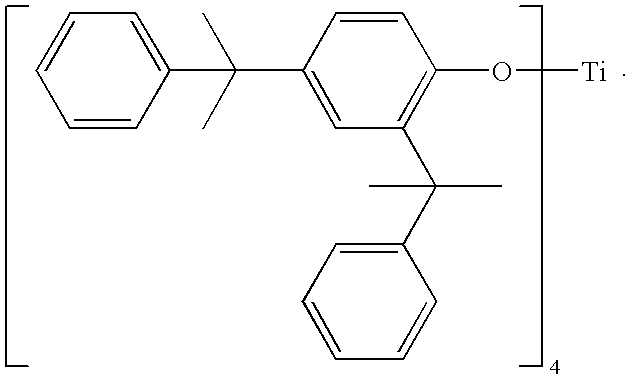Catalytic systems
a technology of catalytic systems and catalysts, applied in catalytic reactions, catalytic activation/preparation, synthetic resin layered products, etc., can solve the problems of high volume ratio, complicated metering and mixing equipment, etc., and achieve the effect of increasing versatility, sufficient time, and rapid polymerization reaction
- Summary
- Abstract
- Description
- Claims
- Application Information
AI Technical Summary
Benefits of technology
Problems solved by technology
Method used
Image
Examples
example 1
[0101]A mixture of 30.0 grams (199.7 mmol) of 4-tert-butylphenol and approximately 100 mL of toluene was charged to a 200-mL three-neck round-bottom flask equipped with distillation adapter, a magnetic stirring bar, and a nitrogen inlet. The mixture was stirred and heated to reflux under nitrogen during which time approximately 20 mL of toluene was removed by distillation. The mixture was then cooled to about 100° C., and 13.47 grams (47.43 mmol) of tetra-isopropyl titanate was added to the mixture via a syringe. The mixture was heated and kept under reflux for an additional 30 minutes at about 160° C., and then isopropyl alcohol was removed by distillation at a distillation temperature within a range from about 85° C. to 90° C. After the liberation of isopropyl alcohol stopped, approximately 50 mL of liquid was removed by distillation at a temperature of about 140° C. The resulting dark red liquid was then cooled to room temperature. Upon cooling, the liquid crystallized yielding a...
example 2
[0102]A mixture of 30.0 grams (145.4 mmol) of 2,6-di-isopropylphenol and approximately 100 mL of toluene was charged to a 200-mL three-neck round-bottom flask equipped with distillation adapter, a magnetic stirring bar, and a nitrogen inlet. The mixture was stirred and heated to reflux under nitrogen during which time approximately 20 mL of toluene was removed by distillation. The mixture was then cooled to about 100° C., and 9.81 grams (34.53 mmol) of tetra-isopropyl titanate was added to the mixture via a syringe. The mixture was heated and kept under reflux for an additional 30 minutes at about 160° C., and then isopropyl alcohol was removed by distillation at a distillation temperature within a range from about 85° C. to 90° C. After the liberation of isopropyl alcohol stopped, approximately 50 mL of liquid was removed by distillation at a temperature of about 140° C. The resulting dark red, viscous liquid was then cooled to room temperature. Upon cooling, the liquid crystallize...
example 3
[0103]A mixture of 40.3 grams (242.9 mmol) of 2-tert-butyl-6-methylphenol and approximately 100 mL of toluene was charged to a 200-mL three-neck round-bottom flask equipped with distillation adapter, a magnetic stirring bar, and a nitrogen inlet. The mixture was stirred and heated to reflux under nitrogen during which time approximately 20 mL of toluene was removed by distillation. The mixture was then cooled to about 100° C., and 16.38 grams (57.7 mmol) of tetra-isopropyl titanate was added to the mixture via a syringe. The mixture was heated and kept under reflux for an additional 30 minutes at about 190° C., and then isopropyl alcohol was removed by distillation at a distillation temperature within a range from about 85° C. to 90° C. After the liberation of isopropyl alcohol stopped, approximately 50 mL of liquid was removed by distillation at a temperature of about 140° C. The resulting dark red, viscous liquid was then cooled to room temperature. Upon cooling, the liquid crysta...
PUM
| Property | Measurement | Unit |
|---|---|---|
| temperature | aaaaa | aaaaa |
| temperature | aaaaa | aaaaa |
| temperature | aaaaa | aaaaa |
Abstract
Description
Claims
Application Information
 Login to view more
Login to view more - R&D Engineer
- R&D Manager
- IP Professional
- Industry Leading Data Capabilities
- Powerful AI technology
- Patent DNA Extraction
Browse by: Latest US Patents, China's latest patents, Technical Efficacy Thesaurus, Application Domain, Technology Topic.
© 2024 PatSnap. All rights reserved.Legal|Privacy policy|Modern Slavery Act Transparency Statement|Sitemap



